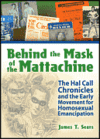 Behind the Mask of the Mattachine:
Behind the Mask of the Mattachine:
The Hal Call Chronicles and the
Early Movement for Homosexual Emancipation
By James T. Sears
Haworth Press; 540 pp; $34.95
Reviewed by Jesse Monteagudo
History – and the lesbian and gay community for which they did so much – ignore and neglect the pre-Stonewall, “homophile” activists. Even today many histories of the gay movement begin with the Stonewall Riots of 1969, tossing aside decades of ground-breaking political, educational and social work. With the exception of the iconic Harry Hay, and a few activists who continued their work and wrote their memoirs in the post-Stonewall years (Jack Nichols, Del Martin and Phyllis Lyon), gay leaders of the 1950s and 1960’s are unknown by today’s generation. Posterity has been singularly unfair to Harold Leland Call (1917-2000). Most of us remember Hall Call, if at all, as part of a conservative clique who in 1953 “stole” the Mattachine Foundation from Hay and other leftist idealists. Later, and after driving out his competition in the newly-named Mattachine Society, Call ruined its image by making it a “front” for his commercial enterprises, including an “adult” book store and movie house – the CineMattachine.
The truth, of course, is more complex. It remained for historian James T. Sears to remove the mask of the Mattachine and reveal the real Hal Call, both man and activist. Based on extensive interviews with Call, his allies and enemies, Behind the Mask of the Mattachine is a tribute to gay America’s first activist generations. In fact, Dr. Sears goes back in time past Call and Company; back to the early part of the 20th Century and courageous trailblazers like Henry Gerber and Manual boyFrank. He then takes Call from his Missouri boyhood to World War II, Colorado journalism and then to San Francisco (1953) in time to confront Hay for leadership of Mattachine. If this book does not show Hay the way that he is accustomed to it is because Dr. Sears has given his opponents, almost for the first time, the right to give their side of the story.
In Behind the Mask of the Mattachine we read about the power plays, bitch fights and ego trips that consumed and eventually destroyed the Mattachine Society. We also learn about the very human men (and a few women) who dared to publicly advocate the rights of homosexuals at a time when most of their fellows were hiding in their closets. At the center of it all was Hal Call. A most contradictory man, Call was both a political conservative and a sexual libertine who hosted orgies in his apartment when most Mattachines (including Hay) were virtually asexual. Call realized, long before they did, that sex was the common factor that brought all gay men together; and it was sex that made us a community.
Behind the Mask of the Mattachine combines two of my favorite topics, politics and sex, as seen through the life of a most extraordinary man and of the Society that he eventually controlled. Dr. Sears reveals Call in all of his complexity; with his faults and failures along with his skills and successes. Thanks to Dr. Sears’ painstaking research, skillful writing and insightful analysis, gay San Francisco in the 1950’s – the Age of Hal Call – comes vividly to life. Today’s generation of activists can learn much from Call and his contemporaries, from both their achievements and their failures.
Jesse Monteagudo is a freelance author, activist and frequent contributor to White Crane. He lives in South Florida with his life partner. Drop him a note at jessemonteagudo@aol.com